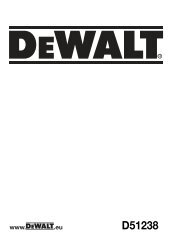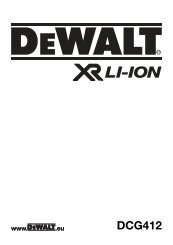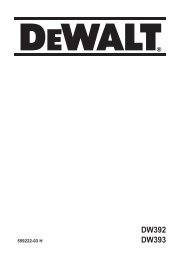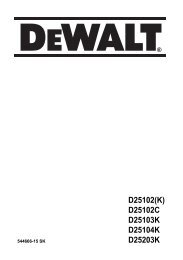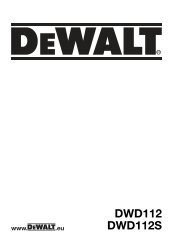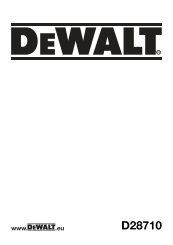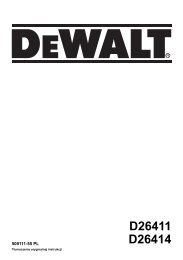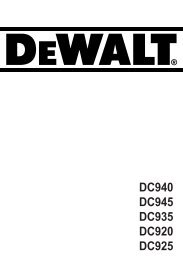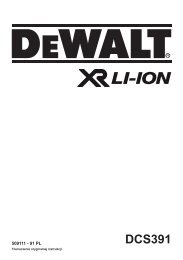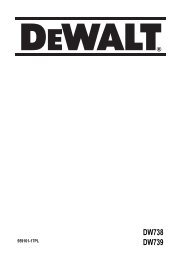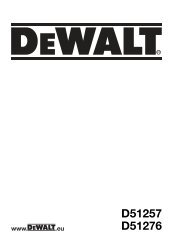Australia - New Zealand - Service - DeWALT
Australia - New Zealand - Service - DeWALT
Australia - New Zealand - Service - DeWALT
You also want an ePaper? Increase the reach of your titles
YUMPU automatically turns print PDFs into web optimized ePapers that Google loves.
Definitions: Safety Guidelines<br />
The definitions below describe the level of severity for each signal<br />
word. Please read the manual and pay attention to these symbols.<br />
DANGER: Indicates an imminently hazardous situation which, if<br />
not avoided, will result in death or serious injury.<br />
WARNING: Indicates a potentially hazardous situation which, if<br />
not avoided, could result in death or serious injury.<br />
CAUTION: Indicates a potentially hazardous situation which, if<br />
not avoided, may result in minor or moderate injury.<br />
NOTICE: Used without the safety alert symbol indicates a<br />
potentially hazardous situation which, if not avoided, may result in<br />
property damage.<br />
IF YOU HAVE ANY QUESTIONS OR COMMENTS ABOUT THIS OR ANY DEWALT TOOL,<br />
CALL US AT: 1800 654 155 (Aust) or 0800 339258 (NZ).<br />
SAFETY INSTRUCTIONS FOR POWER TOOLS<br />
When using power tools, always observe the safety regulations applicable in your<br />
country to reduce the risk of fire, electric shock and personal injury. Read the following<br />
safety instructions before attempting to operate this product. Keep these instructions in<br />
a safe place.<br />
WARNING: To reduce the risk of injury, read the instruction manual.<br />
GENERAL POWER TOOL SAFETY WARNINGS<br />
WARNING! Read all safety warnings and all instructions Failure to follow the<br />
warnings and instructions may result in electric shock, fire and/or serious<br />
injury.<br />
SAVE THESE INSTRUCTIONS<br />
The term “power tool” in the warnings refers to your mains-operated (corded) power<br />
tool or battery-operated (cordless) power tool.<br />
1<br />
1) WORK AREA SAFETY<br />
a) Keep work area clean and well lit. Cluttered or dark areas invite accidents.<br />
b) Do not operate power tools in explosive atmospheres, such as in the<br />
presence of flammable liquids, gases or dust. Power tools create sparks<br />
which may ignite the dust or fumes.<br />
c) Keep children and bystanders away while operating a power tool.<br />
Distractions can cause you to lose control.<br />
2) ELECTRICAL SAFETY<br />
a) Power tool plugs must match the outlet. Never modify the plug in any<br />
way. Do not use any adapter plugs with earthed (grounded) power tools.<br />
Unmodified plugs and matching outlets will reduce risk of electric shock.<br />
b) Avoid body contact with earthed or grounded surfaces such as pipes,<br />
radiators, ranges and refrigerators. There is an increased risk of electric<br />
shock if your body is earthed or grounded.<br />
c) Do not expose power tools to rain or wet conditions. Water entering a power<br />
tool will increase the risk of electric shock.<br />
d) Do not abuse the cord. Never use the cord for carrying, pulling or<br />
unplugging the power tool. Keep cord away from heat, oil, sharp edges<br />
or moving parts. Damaged or entangled cords increase the risk of electric<br />
shock.<br />
e) When operating a power tool outdoors, use an extension cord suitable<br />
for outdoor use. Use of a cord suitable for outdoor use reduces the risk of<br />
electric shock.<br />
f) If operating a power tool in a damp location is unavoidable, use a residual<br />
current device (RCD) protected supply. Use of an RCD reduces the risk of<br />
electric shock.<br />
3) PERSONAL SAFETY<br />
a) Stay alert, watch what you are doing and use common sense when<br />
operating a power tool. Do not use a power tool while you are tired or<br />
under the influence of drugs, alcohol or medication. A moment of inattention<br />
while operating power tools may result in serious personal injury.<br />
b) Use personal protective equipment. Always wear eye protection. Protective<br />
equipment such as dust mask, non-skid safety shoes, hard hat, or hearing<br />
protection used for appropriate conditions will reduce personal injuries.



